"Out of all of the guitars in the whole world, the Fender Mustang is my favourite": The story of Kurt Cobain's Mustangs in Nirvana
From the record-breaking Competition Stripe to the In Utero Sky-Stangs and new Orang-Stang revelations
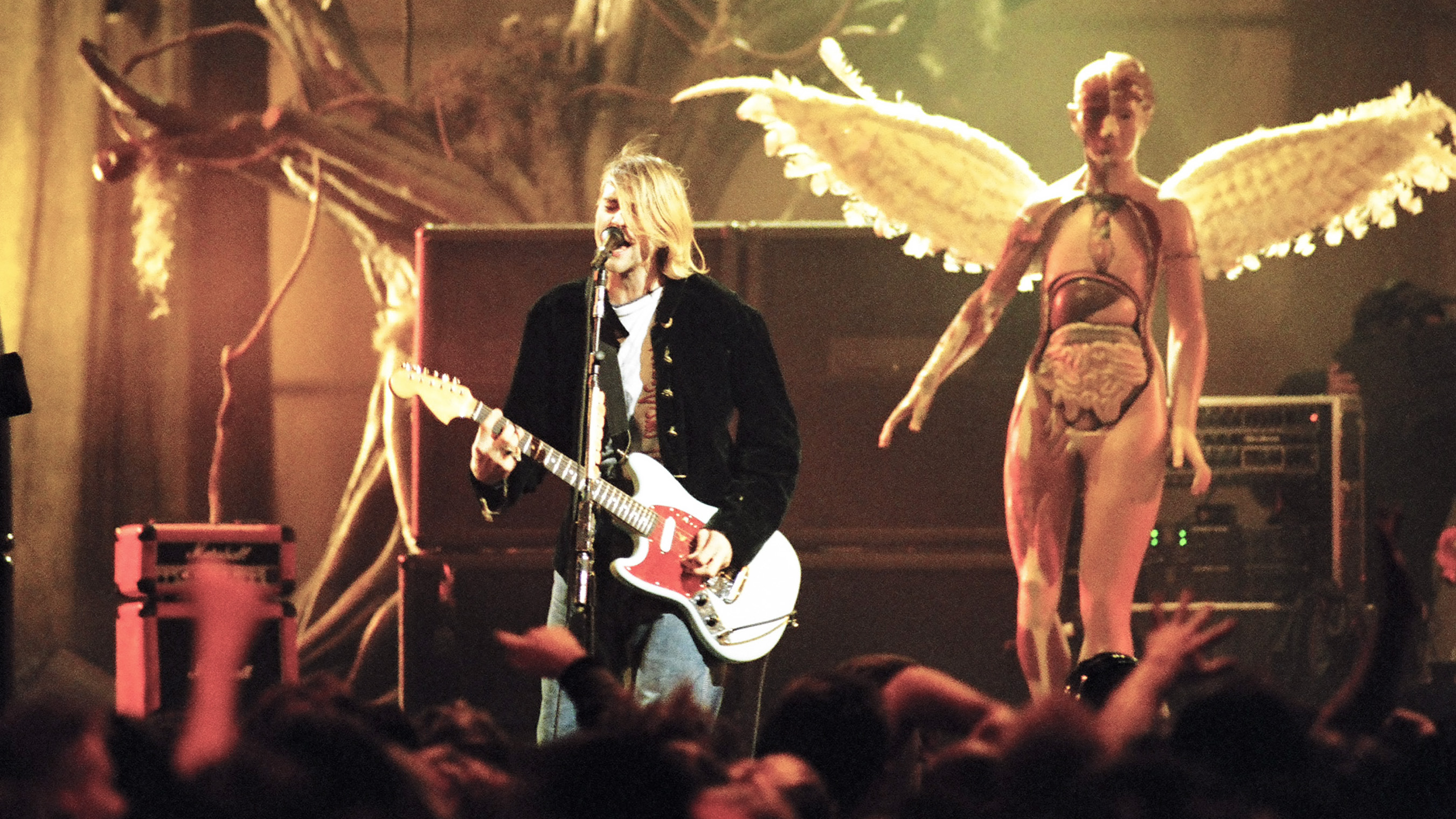
“Out of all of the guitars in the whole world, the Fender Mustang is my favourite.” Kurt Cobain told Guitar World in his final interview with the magazine. At that point (Autumn 1991), Nirvana’s landmark album Nevermind had only just been released, but Cobain, Krist Novoselic and Dave Grohl had been flung head first into heavy rotation and promotion.
Just months before, Nirvana made their daytime appearance at the UK’s Reading Festival, where Kurt brandished his black ‘Vandalism’ Fender Strat, and during this time you’d be just as likely to spot him playing the distinctive, heavily-modded ’65 Jaguar, which has a fascinating story in its own right. Indeed, when Nirvana returned to Reading in 1992, they headlined, and the Jag is the electric guitar that took pride of place for the majority of the set.
However, between its release in August and arrival at the top spot on the Billboard charts the following January, the video for Smells Like Teen Spirit clocked up relentless hours of airplay, all of which featured Cobain and his unusual, but extremely cool-looking Fender Competition Mustang.
It wasn’t his first rodeo with a Mustang; Bleach-era shots, (including the album cover) show Cobain’s first Mustang mainstay, which began life as a stripped-bodied ’Stang that went on to feature a homemade vinyl record scratchplate and a Soundgarden sticker before it had multiple finish changes (white and blue) before finally meeting a similar fate to so many of Cobain’s early guitars.
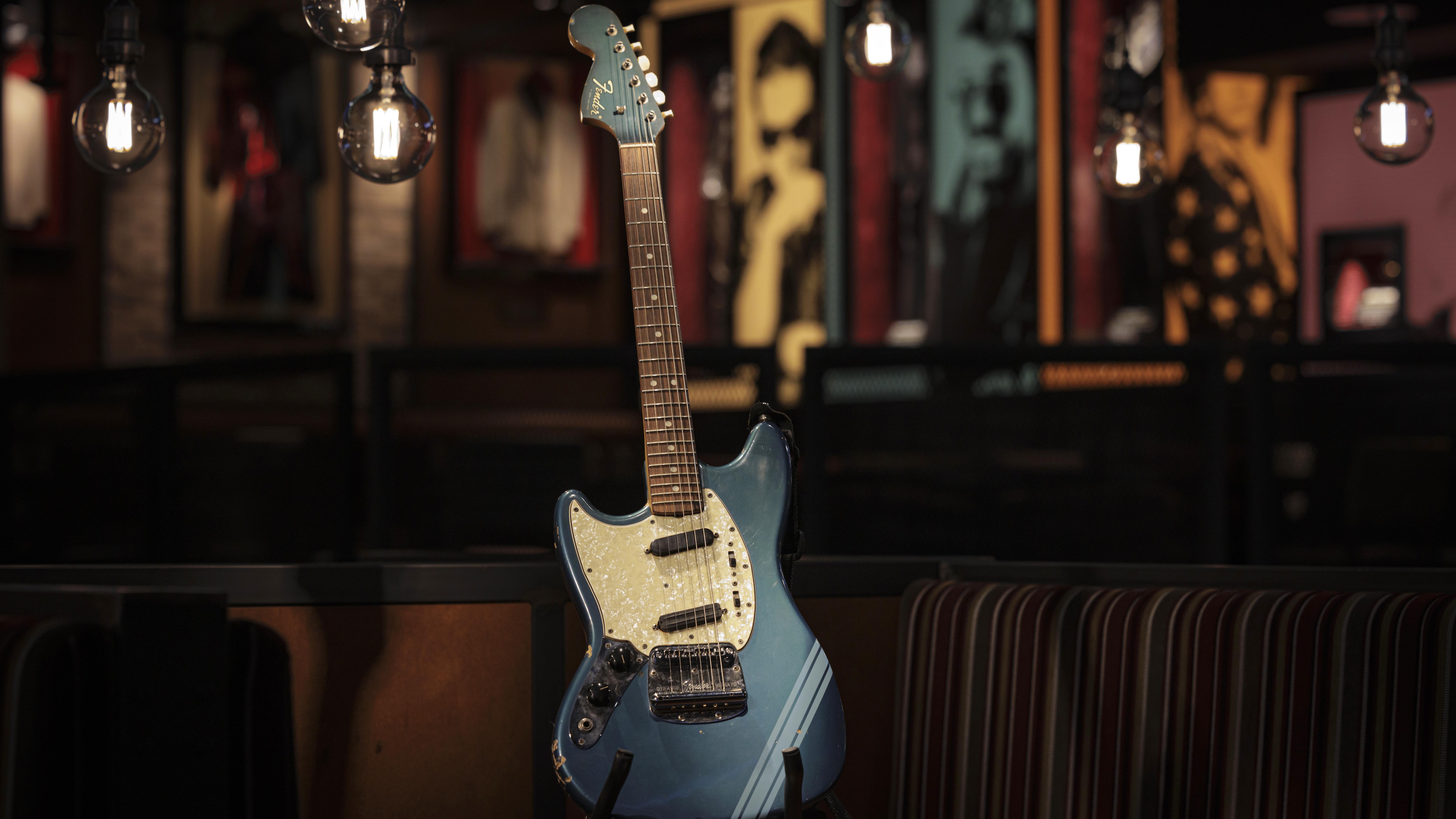
Nor would it be his last. When it came time to tour for 1993’s In Utero, Kurt leant heavily on his “favourite” guitars, giving birth to iconic imagery with either a Fiesta Red or Sonic Blue Mustang, and as we’ll discover, creating yet more extension to the gear myth that surrounded a contrary guitar anti-hero who shunned technique and tone in favour of attitude and songwriting, and won.
As Kurt Cobain’s 1969 Competition Mustang from the Smells Like Teen Spirit video sells for $4.5 million via Julien’s Auctions, join us as we delve into the world of Kurt’s most famous Fender Mustangs and discover why they could just be the definitive Cobain guitars.
Fender 1969 Mustang, Competition Burgundy
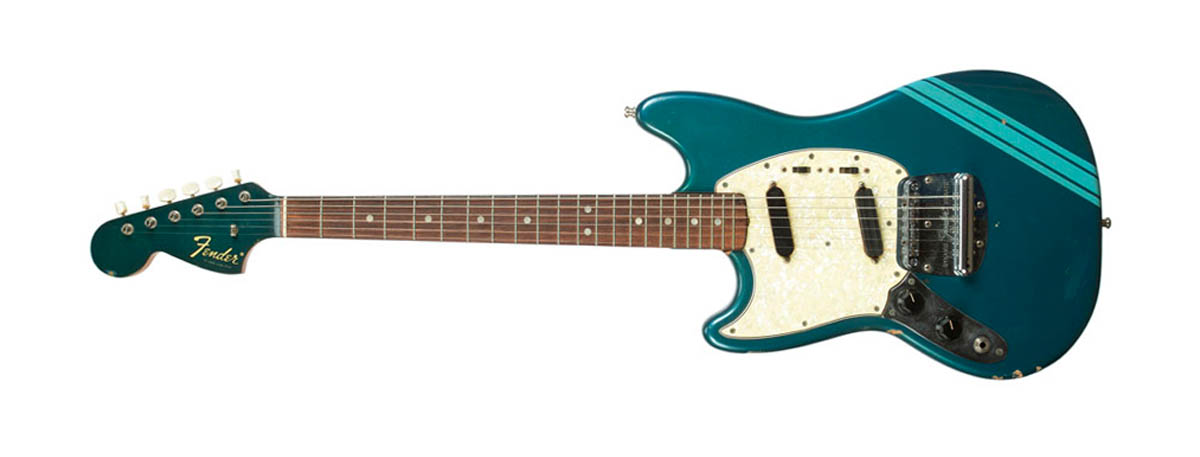
In 1969, Fender introduced a number of updates to the Mustang - its student model which launched in 1964 and evolved from the Duo Sonic. As well as changing the body from a slab to include a forearm contour, Fender introduced its Competition colours: three finishes (Competition Orange, Competition Red and Competition Burgundy), complete with contrasting ‘racing stripes’ across the bass bout of the body, continuing across the back of the guitar.
Want all the hottest music and gear news, reviews, deals, features and more, direct to your inbox? Sign up here.
Kurt Cobain’s Competition Mustang was finished in Competition Burgundy - a confusing title, as for all intents and purposes, it closely resembles Fender’s Lake Placid Blue which is what Kurt’s guitar is often labelled.
To add to this confusion, the 2012 Fender Kurt Cobain Mustang (a part replica/part umbrella homage to Kurt’s love of the Mustang) was issued in Dark Lake Placid Blue, with a light blue Competition racing stripe included.
As with many examples of guitars from this period, ageing over time combined with eye-tricking video and stage lighting (in Kurt’s case), and possibly even discrepancies from its original production means that not all Competition Burgundy paint jobs are equal.
The finish name comes from the addition of a purple tint, most visible around the edges of vintage Competition Mustangs, and as photos have demonstrate, sometimes resulting in an apparent almost-burst effect, or conversely, as is the case with Kurt’s Mustang, a much less prominent, more solid colour.
In some images, Cobain’s guitar looks turquoise, in others, a much darker blue. Regardless, this additional layer to the finish is what gives Competition Blue/Competition Burgundy its name.
Kurt bought the guitar from Voltage Guitars in Hollywood. According to Julien’s Auctions the Mustang was purchased at some point between 1990 and 1991, and was used during the recording of Nevermind. As Nirvana were in Los Angeles recording Nevermind at Sound City Studios, it’s most likely that Kurt acquired the Competition Mustang during this time.
Closer inspection of the Smells Like Teen Spirit video reveals what appears to be the curved profile of the original Mustang bridge, along with what looks like a matching single coil bridge pickup still in place
Part of Kurt’s attraction to Fender’s short-scale/student models such as the Mustang was their availability combined with often low asking prices. This was long before the vintage guitar boom of today, and it’s important to remember that when Kurt laid eyes on the Competition Mustang, it was only just over 20-years old.
That’s old enough to be available used, but not necessarily desirable in the landscape of hot-rodded Super Strats, take-your-eye-out angular guitars, or the tone-laden early-era Stratocasters and Les Pauls of classic rock, all of which were in favour at the time.
It would be wrong to call the Competition Mustang rare, but they certainly aren’t guitars you see every day, and what’s more, Kurt’s guitar was a factory-made left-handed version.
As well as the distinctive finish, rosewood ’board and matching headstock, when Kurt bought the guitar, it was pretty much in its stock state.
Closer inspection of the Smells Like Teen Spirit video reveals what appears to be the curved profile of the original Mustang bridge, along with what looks like a matching single coil bridge pickup still in place.
Julien’s Auctions states that Kurt’s guitar tech, Earnie Bailey replaced the bridge pickup in early 1992, swapping it for a black Seymour Duncan SHR-1 Hot Rails single coil-sized humbucker.
The Competition Mustang was clearly (at least at one point) a favourite guitar of Kurt’s. Perhaps it was the combination of the 24” scale and striking looks, or perhaps it was one of his first ‘proper’ guitars after years of playing cheap lefties, pieced-together or reversed right-handed electrics.
But he chose to play the guitar for the band’s first major label video shoot - while either intentionally or coincidentally wearing a t-shirt that loosely mirrored the colour scheme of the guitar along with the racing stripes - as well as for some of the band’s record release party at Seattle’s Beehive record store.
It’s unclear how closely his acquisition of the Competition Mustang and ’65 Jaguar overlap, but overlap they did. What is known is that the band’s date at the Trees Club in Texas, on 19 October 1991 was an eventful one which features both guitars.
Handycam footage of the gig makes for slightly awkward watching, as Kurt – beginning the set on the Jaguar – struggles with sound issues throughout. After playing Drain You, he swaps to the Competition Mustang for School, Floyd The Barber, Smells Like Teen Spirit, About a Girl and Polly.
The final chord has barely stopped ringing by the time Kurt has the guitar off his shoulders, and with frustrations at a high begins to bludgeon the mixing desk and its flightcase with the butt of the Mustang, Dave Grohl accenting each thump with a crash cymbal. This is where much of the damage visible to the Competition Mustang’s body, a guitar that Kurt reportedly cherished with kid gloves, was sustained.
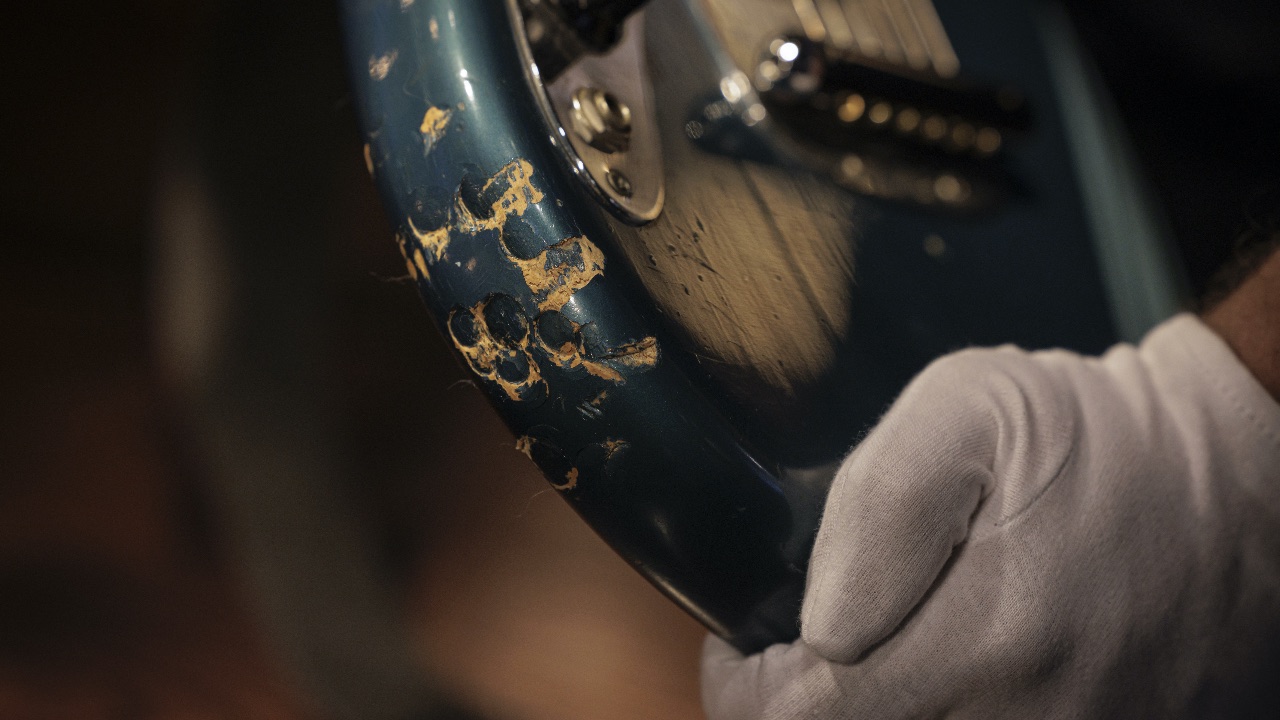
The Trees Club gig was the same date where Cobain, clearly already riled, took umbrage with one of the club’s bouncers while venturing into the crowd via a stage dive, planting him in the head with the body of the Jaguar
By the time he’s finished, the neck is hanging off at almost 45-degrees to the body, and the Competition Mustang suffers one final blow as it’s flung to the stage floor. In an almost symbolic torch-passing, Cobain reinstates the Jaguar, and according to Livenirvana’s excellent resource, the Mustang didn’t appear on stage again until nearly a year later.
But the night wasn’t over yet, and famously, the Trees Club gig was the same date where Cobain, clearly already riled, took umbrage with one of the club’s bouncers while venturing into the crowd via a stage dive, planting him in the head with the body of the Jaguar.
As mentioned above, the Mustang still had its original bridge and vibrato when it came into Kurt’s posession, but Earnie Bailey replaced the bridge for a Stewart MacDonald, then later a Gotoh (reportedly Kurt’s favourite) Tune-O-Matic in preparation for Nirvana’s 1992 dates in Argentina. This swap also saw the introduction of what would become a staple modification Earnie would make to Kurt’s Mustang bridges.
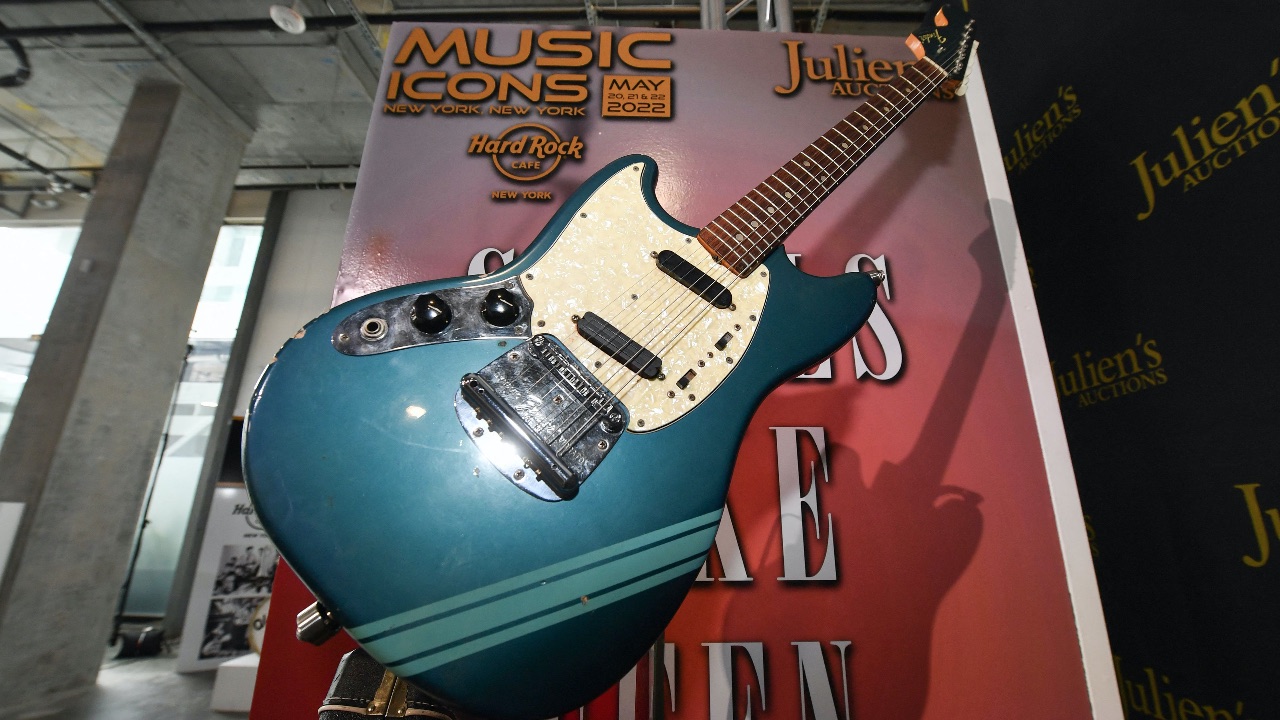
“I rebuilt the bridge section in a way that would be repeated on his In Utero era Sonic Blue Mustangs.” Earnie tells Julien’s. “It involved replacing the [original Mustang] bridge with a Tune-O-Matic-style bridge, and flipping the tailpiece bar around backwards. From there, several washers were added to the posts that connected the tailpiece to allow it to be tightened down against the plate that it rested on.
“This modification solved several problems. It disabled the tremolo system and, in the process, increased tuning stability. Reversing the tailpiece itself allowed us to no re-string the guitar in a much easier process, stabilising the tuning while changing the angle in which the string connected to the bridge which would reduce string breakage.
“By tightening the tailpiece down against the plate, it also redirects the string resonance from being absorbed by the tremolo spring and to the body.”

Kurt’s Competition Mustang had a small number of outings after its encounter with the soundboard in Dallas. But while there are very few photos of the band during the recording sessions for In Utero, engineer Steve Albini remembers Kurt using the Mustang, alongside his ’65 Jaguar, an Univox Hi-Flyer, a custom Jaguar/Mustang (which is most likely a Jag-Stang prototype, but possibly Kurt’s custom Ferrington guitar) and Albini’s own Veleno during the sessions.
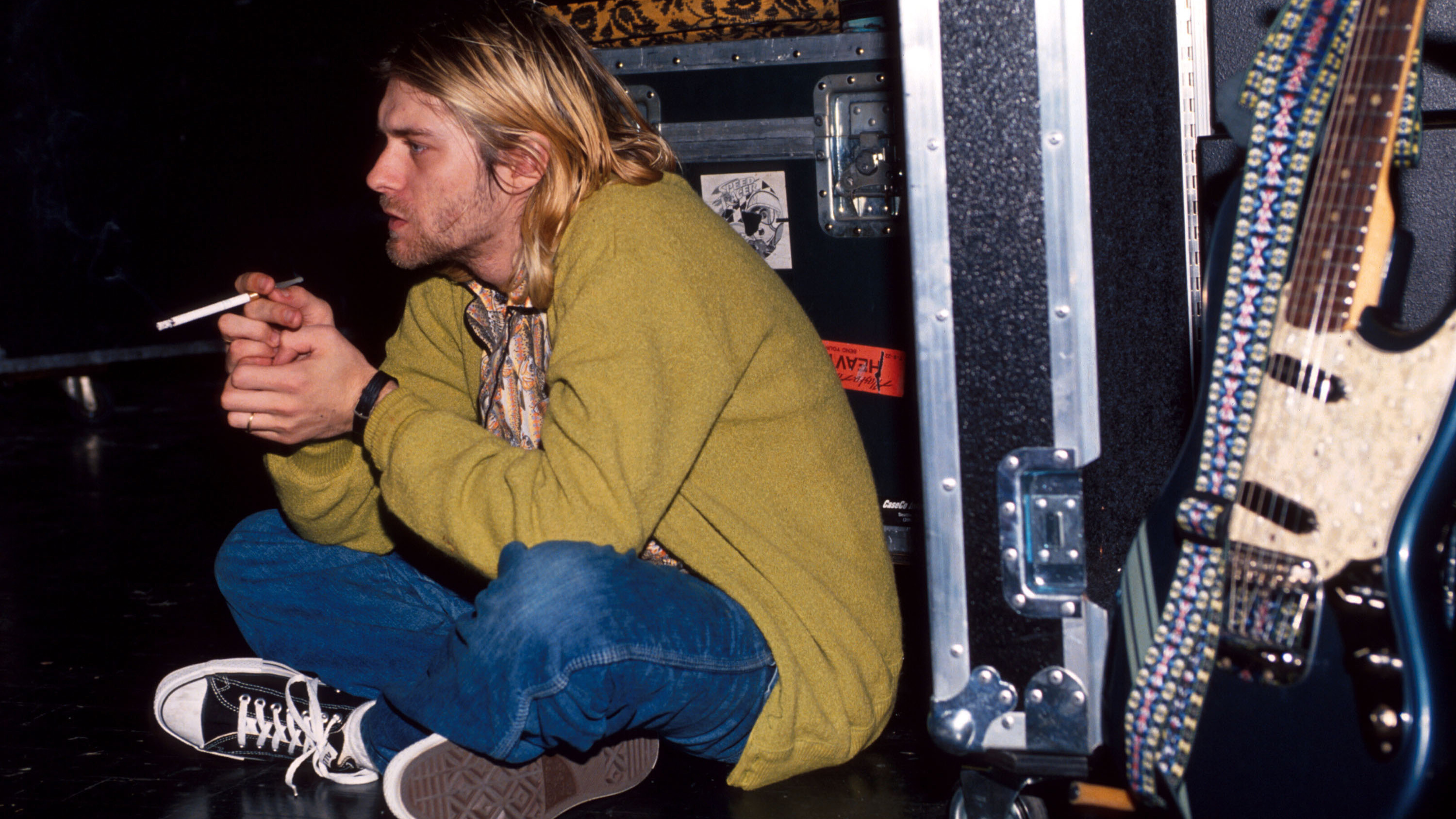
Earnie Bailey has also confirmed to Julien’s that the Competition Mustang was one of the guitars he prepared for the In Utero sessions. Since Kurt’s death, the Competition Mustang has been available for public viewing multiple times: between 2010 and April 2022 it was on display at Seattle’s Museum of Popular Culture (MoPop) and shortly before it was scheduled for auction, was moved to London’s Hard Rock Cafe between 28 April and 3 May 2022.
In Utero-era Mustangs

Four more remained at the time of Kurt’s death. They were sold in Japanese music stores as regular guitars without anyone knowing that they were made for Kurt
Scott Zimmerman
In 1993, as Nirvana prepared to tour for In Utero, Cobain placed an order with Fender for 10 guitars. At the time Fender’s US Custom Shop had just begun operations, but weren’t yet set up to make left-handed necks.
The work of building the guitars subsequently fell to Scott Zimmerman, a longtime employee and master builder of Fujigen - the company that made Fender’s Japanese guitars. Zimmerman has been active online in an attempt to clear up some of the confusion surrounding Kurt’s In Utero-era Mustangs, and in addition to this provided Julien’s Auctions with a letter of provenance when one of the Sonic Blue Mustangs (see below) was auctioned in 2019.
“In 1993, I was contacted by a friend who was Fender Guitar’s artist relations manager, about building a left-handed Fender Mustang for Kurt Cobain of the band Nirvana…” the letter begins.
“Fujigen agreed to let me build the guitar, however they asked for an order of more than one guitar. Ten guitars were ordered and the idea was to ship two at a time over a period of months. The guitars were stock ’69 Mustangs, both Fiesta Red and blue.”
“A blue guitar and a Fiesta Red one were shipped in June 1993 to Kurt; two blue ones were shipped in October 1993, and two Fiesta Red ones were shipped in February, 1994. Four more remained at the time of Kurt’s death. They were sold in Japanese music stores as regular guitars without anyone knowing that they were made for Kurt.”
“Your [auction] guitar was shipped on 10/22/93 and is rare, with the small contour body decal on the head. Only the two shipped on 10/22/93 had this…”
These guitars have in many ways become as iconic as his Competition Mustang, modified Jaguar and Vandalism Strat due to their heavy use during the band’s final year
Now, Zimmerman’s confirmation details that six Mustangs were sent to Kurt prior to his death, as well as the two Jag-Stangs for which he built the necks, and Fender’s Larry Brooks completed.
The final two guitars were Fiesta Red, meaning that up until two months before he died, Kurt had only received one Fiesta Red Mustang. As Nirvana were still on tour during these months, it’s unlikely that either of these guitars made it into live circulation, and their whereabouts has seemingly been forgotten.
It’s possible that these have remained in the Cobain estate, or, as we’ll see, that they were among a number of Kurt’s guitars given away by Courtney Love to fans and friends. Finally, as Zimmerman states, the guitars were originally built as stock 1969 Mustang reissues, suggesting that the neck single coils fitted to the Mustangs were also stock Fender pickups.
These guitars have in many ways become as iconic as his Competition Mustang, modified Jaguar and Vandalism Strat due to their heavy use during the band’s final year. Cementing the Mustang’s place in the Cobain gear arsenal was the triumphant MTV Live and Loud concert, where Kurt used his Mustang for almost every song except the dropped-tuned Blew, and set-closer/Nevermind secret track, Endless Nameless (where he swapped to a Strat).
It also gave birth to another common misconception: that Kurt owned and played a white Mustang. The stage lighting once again has a part to play here, as the Sonic Blue under bright, cool lights appears white in some still photos.
The four guitars were eventually routed for bridge humbuckers, and Earnie Bailey implemented the same Tune-O-Matic bridge swap and modifications as the Competition Mustang. The Mustangs also had their pickup slide-toggle switches trimmed so as to avoid being accidentally knocked while being played.
Collectively, the three Sonic Blue Mustangs have become known as Sky-Stangs (a name given to the guitars by Kurt and Earnie Bailey), with three almost identical, but not-quite-the-same guitars
Each of the guitars were given nicknames, two of which which can be seen in Fender’s behind-the-scenes video above. Fender’s Justin Norvell and Justin Perez were given access to a number of Cobain’s guitars during the development of the Fender Kurt Cobain Mustang (which featured the H/S configuration of the In Utero guitars, but with the option of Competition, Fiesta Red or Sonic Blue finishes).
The Fiesta Red Mustang was nicknamed Oranj-Stang, while Blue Mustang is seen written on masking tape stuck to one of the cases. Collectively, the three Sonic Blue Mustangs have become known as Sky-Stangs (a name given to the guitars by Kurt and Earnie Bailey), with three almost identical, but not-quite-the-same guitars.
As well as being instantly recognisable as a Cobain guitar, the Sky-Stangs have also set the template for DIY mods among Cobain fans. In relation to the Jaguar, with it’s plethora of idiosyncrasies, the Sky-Stang mods are arguably less fiddly to replicate, and used prices of the now-discontinued KC Mustang can often be out of reach.
Fender 1993 Fiesta Red Mustang (Oranj-Stang) and emergence of new information
The Fiesta Red Mustang was the first of the Japanese Scott Zimmerman Fenders to get a live airing. There’s every chance you’ve seen photos of its live debut at the pre-Pat Smear Roseland Ballroom gig in July 1993, where Kurt wore his 'Dennis The Menace' red/black striped jumper from the Sliver video, which yet again suggests that perhaps Kurt did think a bit more about his on-stage image than he’d liked to have let on.
The Oranj-Stang would only have been a few weeks old when it made its debut, and as such photos and footage show it in the closest thing to its original condition. The Fiesta Red finish is met by a red tortoise shell scratchplate, and as with the other Mustangs, a rosewood fingerboard.
As-per Zimmerman’s confirmation, the headstock only features the Fender logo decal, but at the time of the Roseland date, it’s possible to make out that Kurt has had what appears to be a Seymour Duncan JB Jr, single coil-size humbucker fitted in the bridge position.
Fast-forward a few months, and Kurt has begun to incorporate the other Zimmerman Mustangs into Nirvana’s live sets, along with his Jag-Stang. By late 1993, the guitar has had its scratchplate switched for a white Pearloid plate, and the bridge humbucker has been swapped for a black, full-size humbucker (most likely a Seymour Duncan JB in line with the other guitars).
As evidenced by Fender’s behind-the-scenes vault video, an Oranj-Stang has remained in the Cobain estate, but new information received by MusicRadar opens new questions about the history of the Oranj-Stang guitars Cobain used onstage with Nirvana and where at least one of them is now.
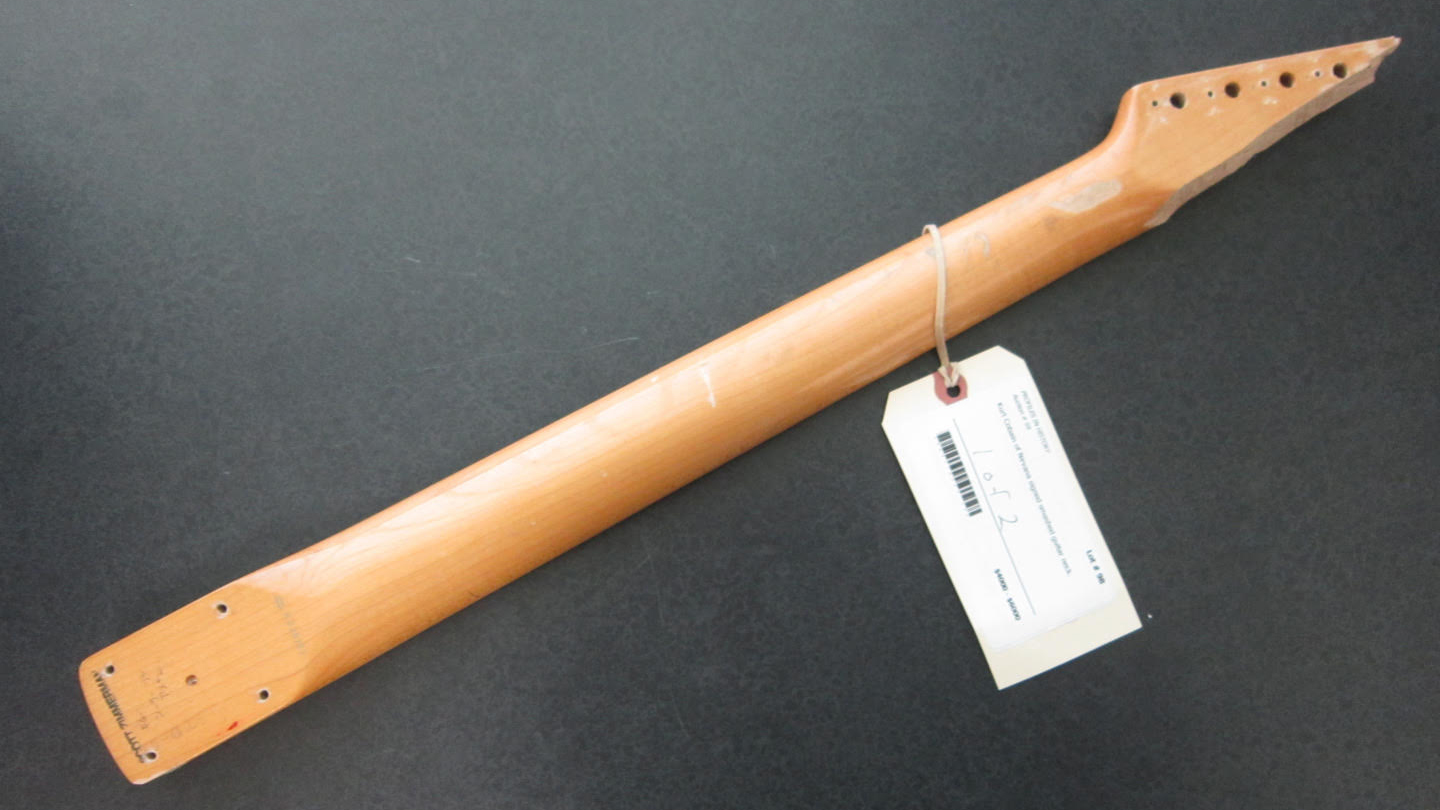
In 2023, MusicRadar was contacted by the winner of an auction (who wishes to remain anonymous) that took place a decade ago for a signed Kurt Cobain guitar neck.
"The story was that the guitar neck was given to a fan by Kurt Cobain's guitar tech on December 30, 1993 after a Nirvana concert at the Great Western Forum Club in Inglewood, California," they told us.
"The neck came with a picture of Kurt singing the guitar and some fan club & crew badges from that night. Prior to the acquisition, I received a picture of the back of the neck and matched some marks from Kurt's picture with marks on the back of the neck. There were multiple perfect matches. Everything looked good so I acquired it."
When the buyer received the neck things took an interesting turn.
"Then I started researching about the show where the guitar was smashed so I could maybe create a nice memorabilia display with it," they told MusicRadar. "Luckily, the whole 30 December [1993] show at Great Western Forum was available on YouTube [see video clip above where Cobain throws his guitar into the air at the end of the song Blew]. I found the sequence in it where Kurt destroys the guitar but there was a problem: Kurt is destroying a black Fender Strat and the neck [I have] has a vivid red paint mark on it. "
So what neck did they buy in the auction?
"The neck also had some Japanese inscriptions and the name Scott Zimmerman stamped under the veneer on it so I decided to reach out to him to see if he could provide more information about it," the buyer told us. "He replied with the following:
'From 1980 until the end of 1984 I was the sole Masterbuilder of prototype and artist guitars at Fender USA. In 1990 I began working for the Fujigen factory here in Matsumoto Japan in the same capacity making Fender Ibanez and other brands. Because the US Fender Custom Shop was not up and running enough to handle the job Fender USA asked Fujigen if I could make a custom left-handed Fender Mustang for Kurt Cobain for them. The president of Fujigen agreed but insisted that it would have to be more than one guitar.
The pictures you sent are most certainly one of the guitars sent to Kurt, from the red mark on the heel it was one of the Fiesta red models
Scott Zimmerman
'Fender USA talked to Kurt and he agreed to 10 guitars to be custom made by me for him, five to be the Sonic Blue, five to be Fiesta Red. I made the ten necks and bodies and we finished and shipped them two at a time. I had shipped a total of six guitars when Kurt died. The remaining four were bought by the Fender Japanese distributor and just dumped into the Japanese market as nothing but lefty Mustangs.
"The pictures you sent are most certainly one of the guitars sent to Kurt, from the red mark on the heel it was one of the Fiesta red models. There is no doubt, with my name stamp on the heel under the finish and my personal Japanese writing designating which logo decal and what finish to spray on the neck for the paint dept, to follow.'

So it's a Mustang neck from a Fiesta Red model. But how and when it was parted from the body is still unclear. Cobain's usual guitar tech Earnie Bailey wasn't working with the band on the night the neck was believed to have been given to a fan (30 December 1993) so hasn't been able to shed more light on that side of things, according to the buyer.
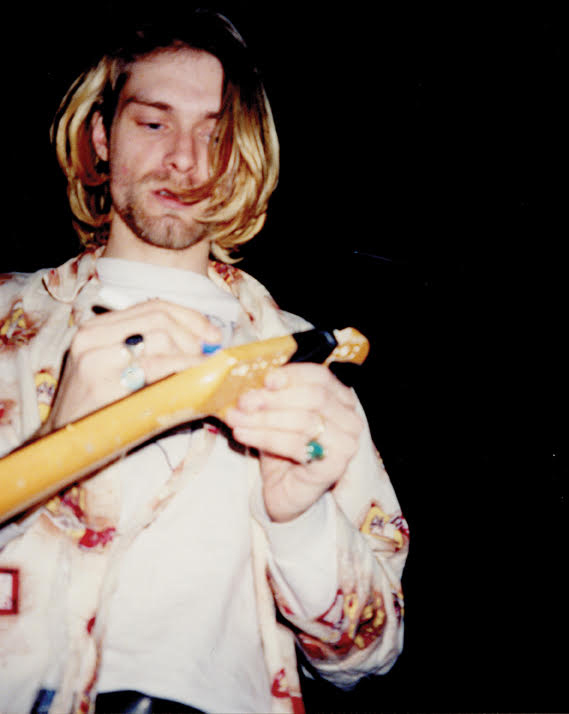
Meanwhile, Zimmerman took time to send a follow-up email where he offered the neck's new owner the exact dates of when Cobain's custom Mustangs were shipped to him:
• One Sonic blue and one Fiesta Red Mustang were shipped on 28/6/1993
• Two Sonic Blue Mustangs were shipped on 2/10/1993
• Two Fiesta red Mustangs were shipped on 4/2/1994
From those dates we can see only one Fiesta Red 'Oranj-Stang' guitar could have been in Cobain's possession in the time period when the neck was said to have been signed by Cobain. Is that the guitar the neck comes from? If so, where is the rest of it? Was it even smashed on the 30 December Inglewood show if there's no evidence of it happening onstage?
The buyer also highlighted that on 4 February Nirvana performed Drain You in Paris, France for the French TV show Nulle Part Ailleurs. The appearance is memorable for a few reasons; the band are wearing shirts, ties and waistcoats and Cobain's guitar cut out during the song's mid-section and he threw it on the floor. The guitar; a Fiesta Red Mustang. Was this one of the second and third Fiesta Red Mustangs that Zimmerman's records show were shipped (does that mean received?) on that exact date?
There are a lot of questions remaining that can hopefully be answered at some point – if you have any new information to shed light on the broken Oranj-Stang, let us know!
Fender 1993 Sonic Blue Mustang (Sky-Stang I)
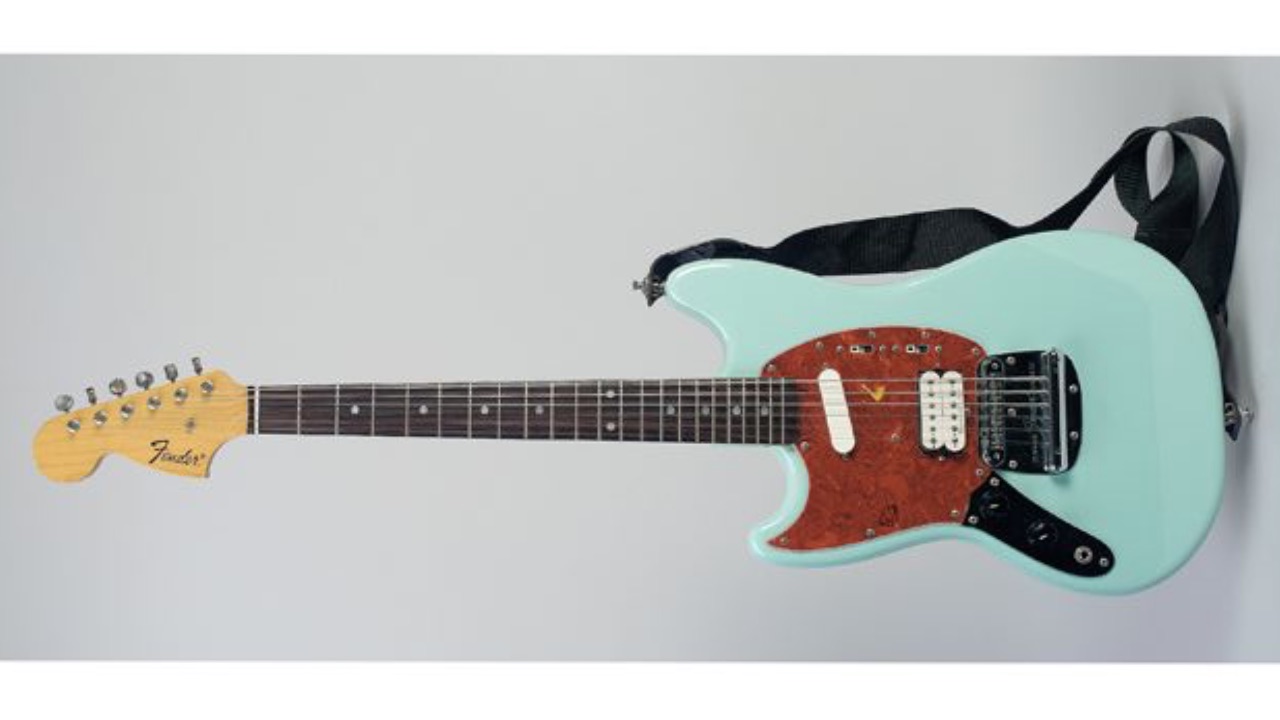
Of the three Sky-Stangs, Kurt’s Sky-Stang I is the most easily, and most commonly spotted In Utero Mustang.
Thanks to Nirvana’s MTV Live and Loud performance - where the guitar featured almost exclusively - many stills of the In Utero era are of Kurt playing this guitar, but he did also use it more than the other two blue Sky-Stangs.
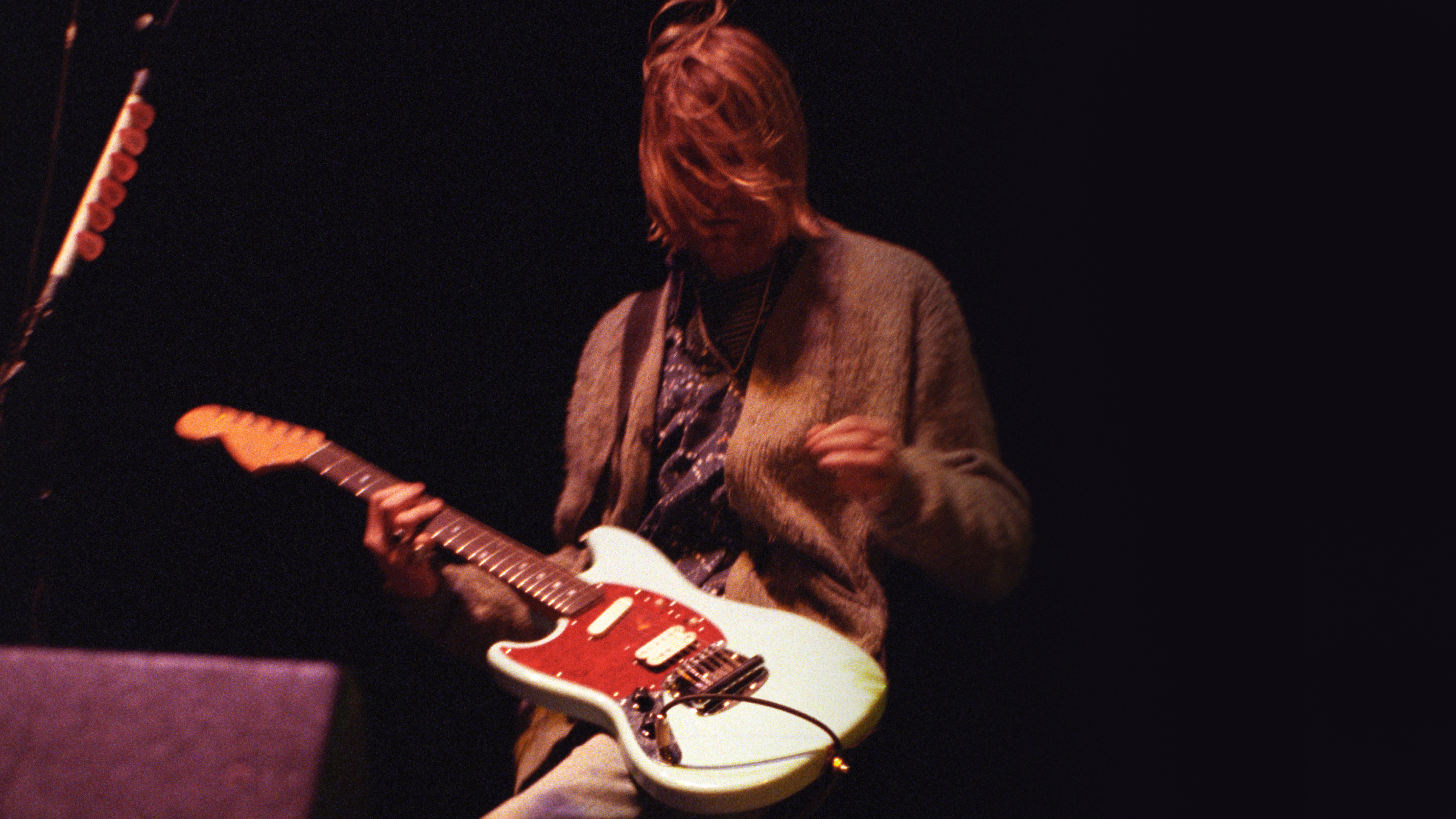
It is similar in construction to the others: rosewood fingerboard, Sonic Blue finish, red tortoiseshell scratchplate, but as Zimmerman mentions in his online posts, this is one of the guitars that didn’t feature the “Offset Contour Body” decal on the headstock.
The biggest defining feature, though, is that the Sky-Stang I featured a white humbucker in the bridge position rather than the other Sky-Stangs’ black Seymour Duncan JBs.
The Sky-Stang I can be thought of as the quintessential Cobain Mustang, even though the official Fender Kurt Cobain Mustang – along with many DIY replicas – include the black humbucker in the bridge
Given that Kurt had JBs fitted into the other guitar, and what certainly appears to be a JB Junior in the Fiesta Red Oranj-Stang, it’s a fair assumption that this Sky-Stang also featured a JB.
Kurt’s other favoured bridge humbuckers included a Seymour Duncan Hot Rails, and the DiMarzio Super Distortion fitted in the Jaguar. However, in photos taken during Nirvana’s Live and Loud set where the bridge humbucker is visible, the pole pieces don’t appear to feature a recessed 'dip' in the way that a Super Distortion’s do.
The Sky-Stang I can be thought of as the quintessential Cobain Mustang, even though the official Fender Kurt Cobain Mustang – along with many DIY replicas – include the black humbucker in the bridge. This guitar remained in Kurt's live arsenal right up to Nirvana's final gig at Munich's Terminal One.

It spent years on display Seattle MoPOP museum as part of the Nirvana: Taking Punk to the Masses exhibition alongside a treasure trove of Kurt and Nirvana instruments and memorabilia. Then in October 2023 its owner was revealed; Cobain's half-brother Chad Cobain, and he was putting it up for auction, with a portion of the proceeds going towards Kicking The Stigma, The Indianapolis Colts and Irsay Family’s mental health awareness initiative.
Estimated at $1-2 million, we expected it to go for much more in light of the Competition Stripe Mustang's record-breaking auction $4.5 million price and the fact it was one of Cobain's favourite and extensively-used live guitars. But on November 18 2023 it sold for $1,587,500 via Julien's Auctions in Nashville. Still a considerable amount, of course!
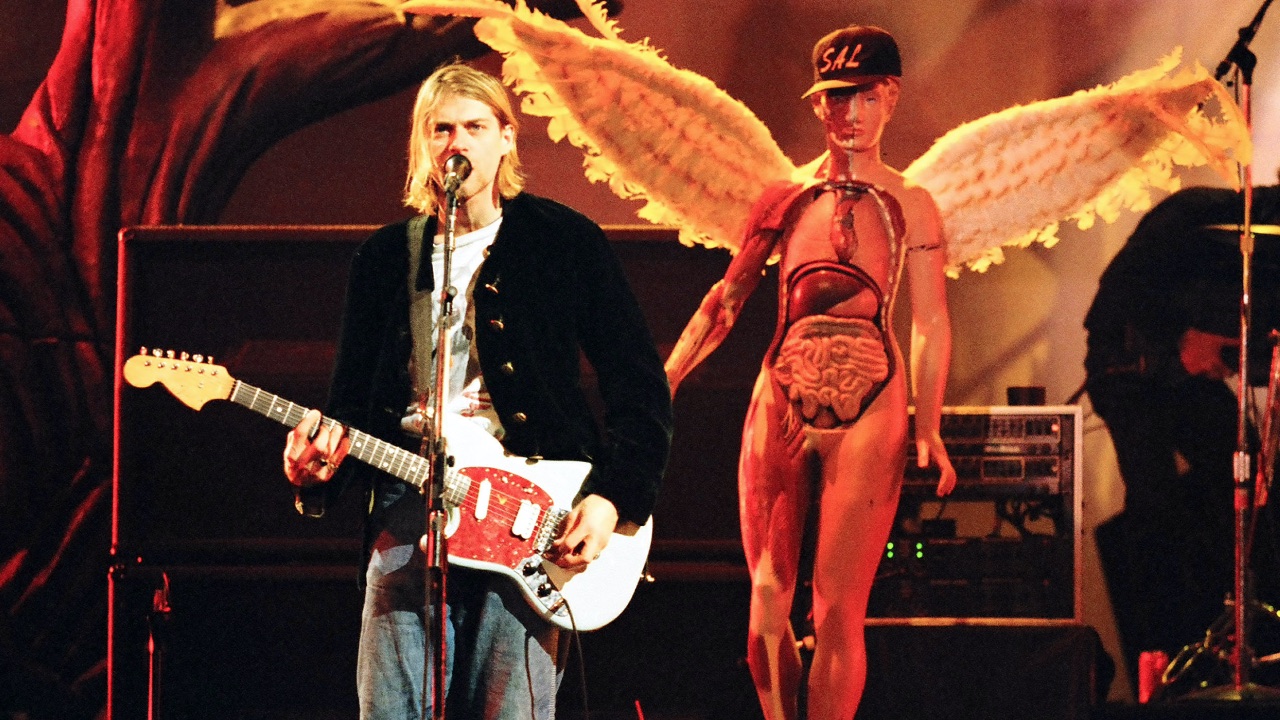
The winning bidder wasn't Competition Mustang's current owner Jim Irsay, but Japan-based businessman Mitsuru Sato. But like Irsay – who has taken his famous guitar purchases like the Black Strat on a touring display – it seems he had no plans to hide the guitar away for himself.
“I want to pass on rock to the next generation in a real way," Sato said. "We would like to use this guitar to support the next generation aiming to pursue music.
Fender 1993 Sonic Blue Mustang (Sky-Stang II/Blue Mustank)
While we say it was played the 'least', we should highlight that the Sky-Stang II definitely did make it on stage, contrary to popular belief
The Sky-Stang II was the guitar used least live by Kurt and it has remained in the Cobain estate vault largely out of the limelight since Kurt’s death.
But while we say it was played the 'least', we should highlight that the Sky-Stang II definitely did make it on stage, contrary to popular belief.
Nirvana’s show on 2 Dec 1993 in Tallahassee is something of a cross-section of all Kurt’s In Utero-era Mustangs. He begins the set with the Jagstang, moves to the Sky-Stang I before breaking a string during Lithium and finishing the song on the Jag-Stang.
Next up is Pennyroyal Tea, and Kurt swaps the guitar for a blue Mustang with a black humbucker, once the stage lights change during the song, it’s clear that the guitar he is playing features the distinct scratchplate marking of the Sky-Stang II, suggesting that this guitar was taken on the road as a backup rather than left at home.
What is clear, is that it was produced in the same two-guitar batch mentioned by Scott Zimmerman, and is essentially an identical guitar to the Sky-Stang III.
There is some further documentation of the Sky-Stang II - a large photo of the guitar is featured in the Cobain Unseen book, as well as the video produced by Fender, which focusses mostly on the Sky-Stang.
Once again the scratchplate is an identifier, with another patch of yellow/orange clearly visible between the bridge pickup and the guitar’s controls. Elsewhere, we can see the “Offset Contour Body” decal on the headstock denoting it is the counterpart to the Sky-Stang III, and the video shows the black Seymour Duncan humbucker in detail.

With the pickup removed from the cavity and turned over, the video reveals a sticker reading JBJ. Seymour Duncan’s labelling system at the time included the first letter of the winder’s last name, and here the additional ‘J’ stands for Maricela Juarez who currently runs the Seymour Duncan Custom Shop.
Interestingly, the metal backplate of Kurt’s JB is only drilled for six threaded polepieces, whereas later models were drilled under both sides of the humbucker so that the backplates could be used universally between bridge and neck pickups - a small detail which could mean that the pickup was actually produced in the '80s rather than being a brand new pickup.
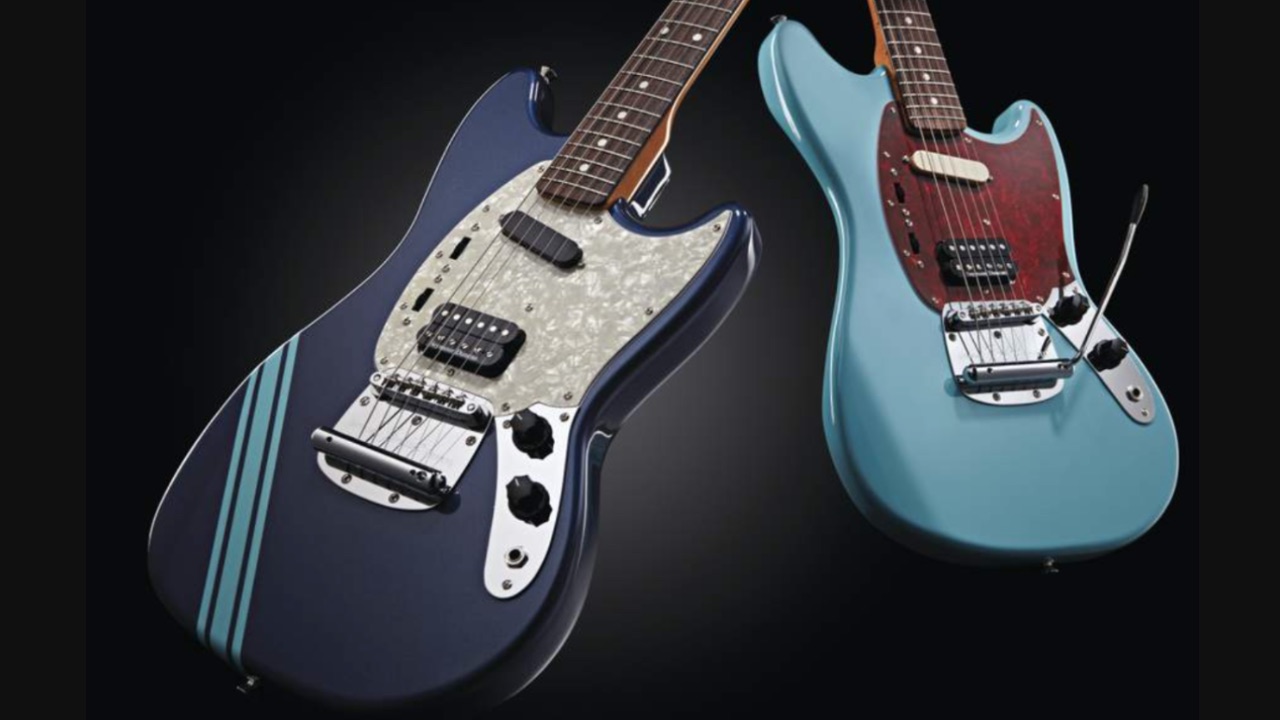
Fender 1993 Sonic Blue Mustang (Sky-Stang III)
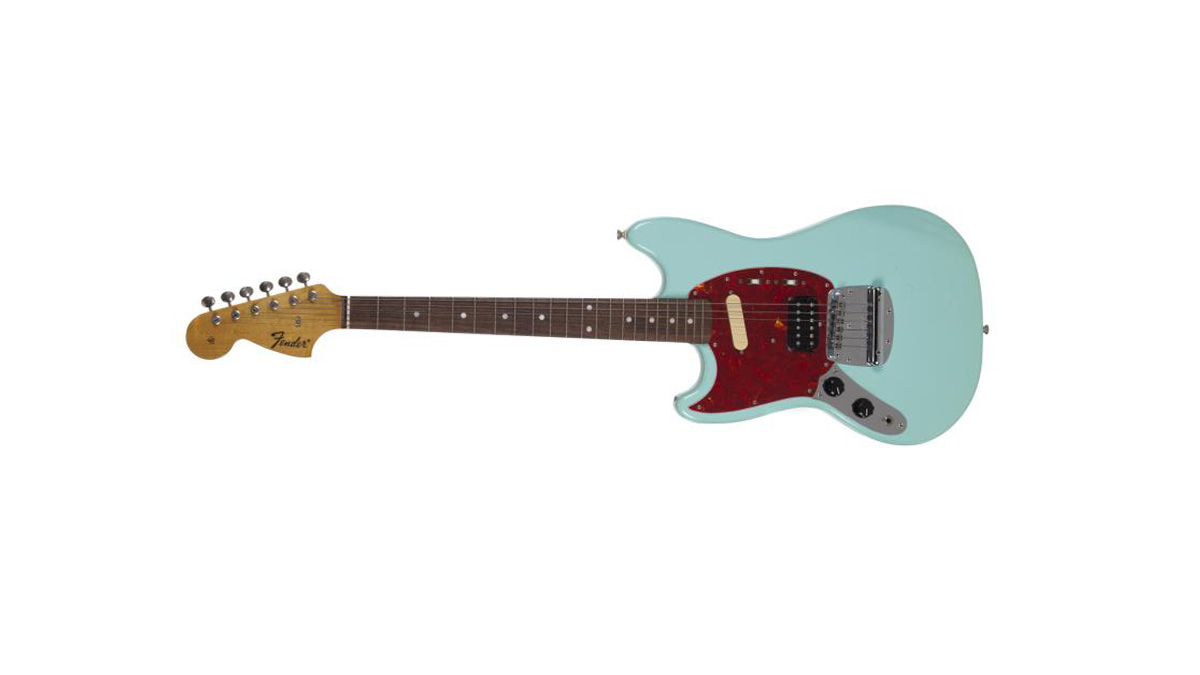
The Sky-Stang III is one of two Sonic Blue Mustangs known to have been used live most often by Cobain. It features a few identifying characteristics. First, it was fitted with a black Seymour Duncan JB humbucker in the bridge position, fitted by Earnie Bailey, which immediately sets it apart from the Sky-Stang I.
Next, it has a noticable patch of yellow/orange in the red tortoiseshell scratchplate, which can be seen between the pickups, just inside the bridge humbucker. Finally, it includes a “Custom Contour Body” decal on the headstock, which Zimmerman confirmed to Julien’s Auctions was only applied to two of the guitars.
The guitar was released from Cobain’s estate a few months after his death when Courtney Love received a letter from then-teenage fan, Bobby Costello. Love replied to the fan’s letter with a handwritten message of her own, as well as gifting him this guitar.
The letter, which has been circulated online and remained with the guitar reads, “It may shock you, but your letter touched me a lot and this was one of his favourite guitars. When they delivered all of them the other day I felt so horrible. Kurt loved, more than anything, that kids liked his music and I just felt him over my shoulder when I read your letter. Kurt is left handed so you have to have the guitar professionally turned around or simply restring it - good luck. Courtney”.
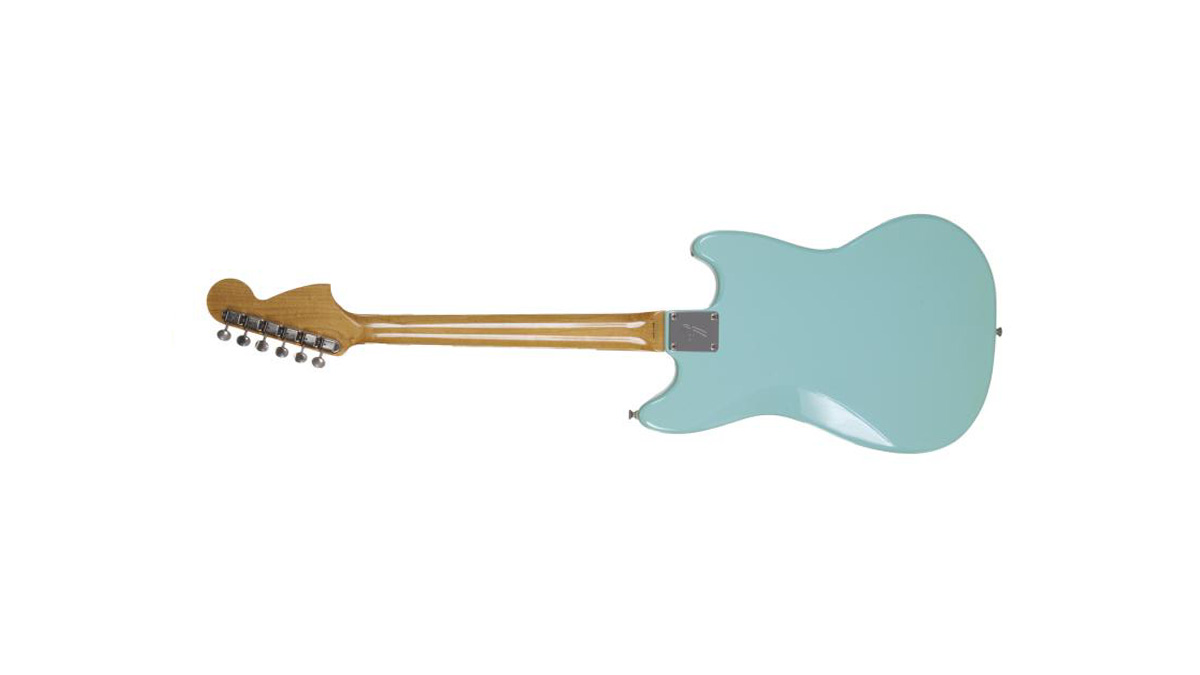
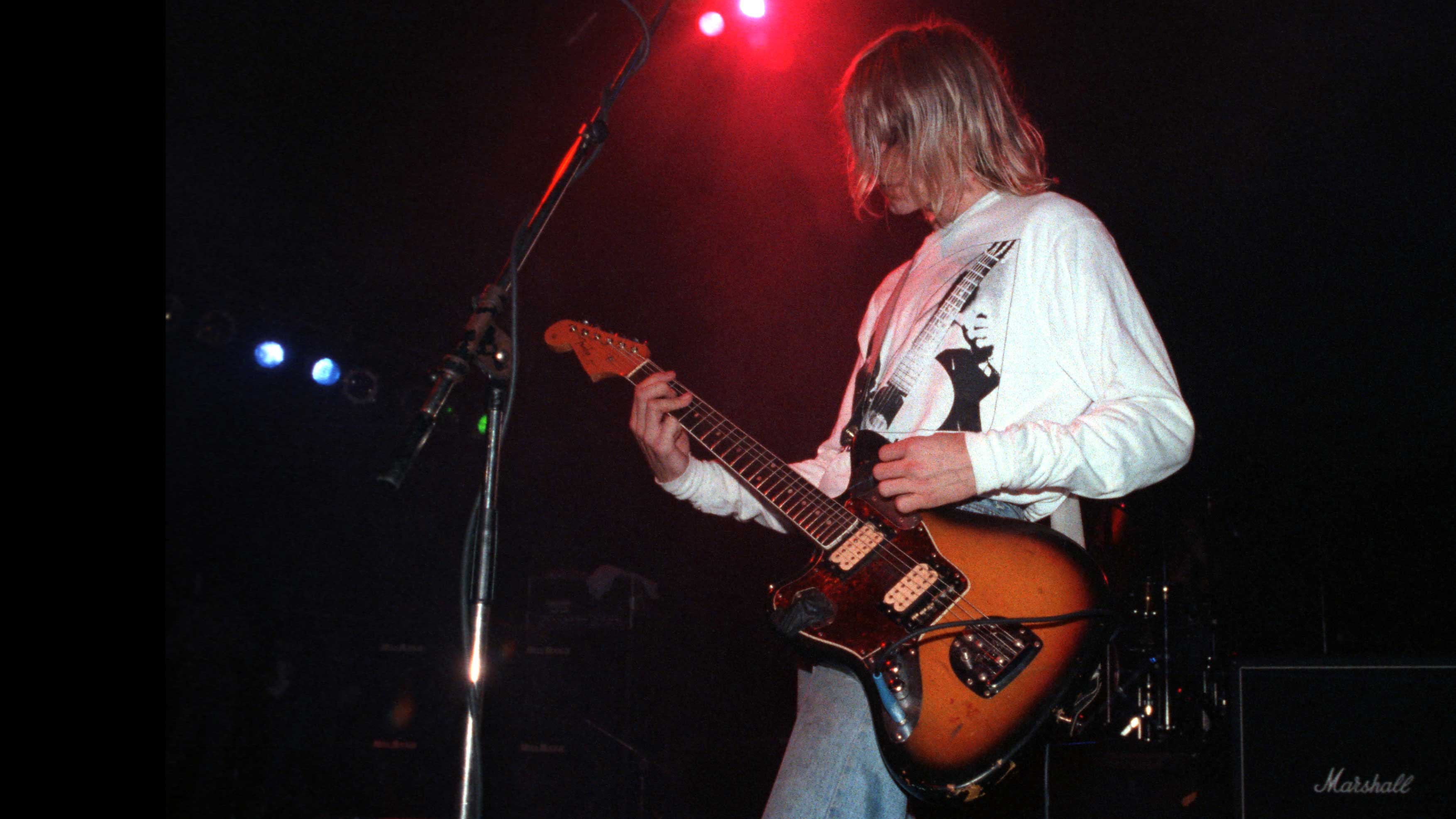
Photos of Bobby Costello with the guitar show the flightcase, cleary marked as Sky-Stang III. The guitar remained in Costello’s possession for a number of years, but in 2012, Costello posted to a Facebook page named Kurt Cobain Guitars alleging that the guitar was taken without his permission and sold without his consent.
At the time of his post, the guitar was exhibited at the Rock & Roll Hall of Fame museum in Cleveland, Ohio, where a fan jumped a security barrier and stole the volume and tone knobs from the guitar (these were replaced by the museum with identical control knobs).
The Sky-Stang III was later auctioned via Julien’s Auctions in 2019 (the origin of Zimmerman's letter to the auction house) where it fetched a total of $340,00.

Stuart has been working for guitar publications since 2008, beginning his career as Reviews Editor for Total Guitar before becoming Editor for six years. During this time, he and the team brought the magazine into the modern age with digital editions, a Youtube channel and the Apple chart-bothering Total Guitar Podcast. Stuart has also served as a freelance writer for Guitar World, Guitarist and MusicRadar reviewing hundreds of products spanning everything from acoustic guitars to valve amps, modelers and plugins. When not spouting his opinions on the best new gear, Stuart has been reminded on many occasions that the 'never meet your heroes' rule is entirely wrong, clocking-up interviews with the likes of Eddie Van Halen, Foo Fighters, Green Day and many, many more.
- Rob LaingReviews Editor, GuitarWorld.com and MusicRadar guitars